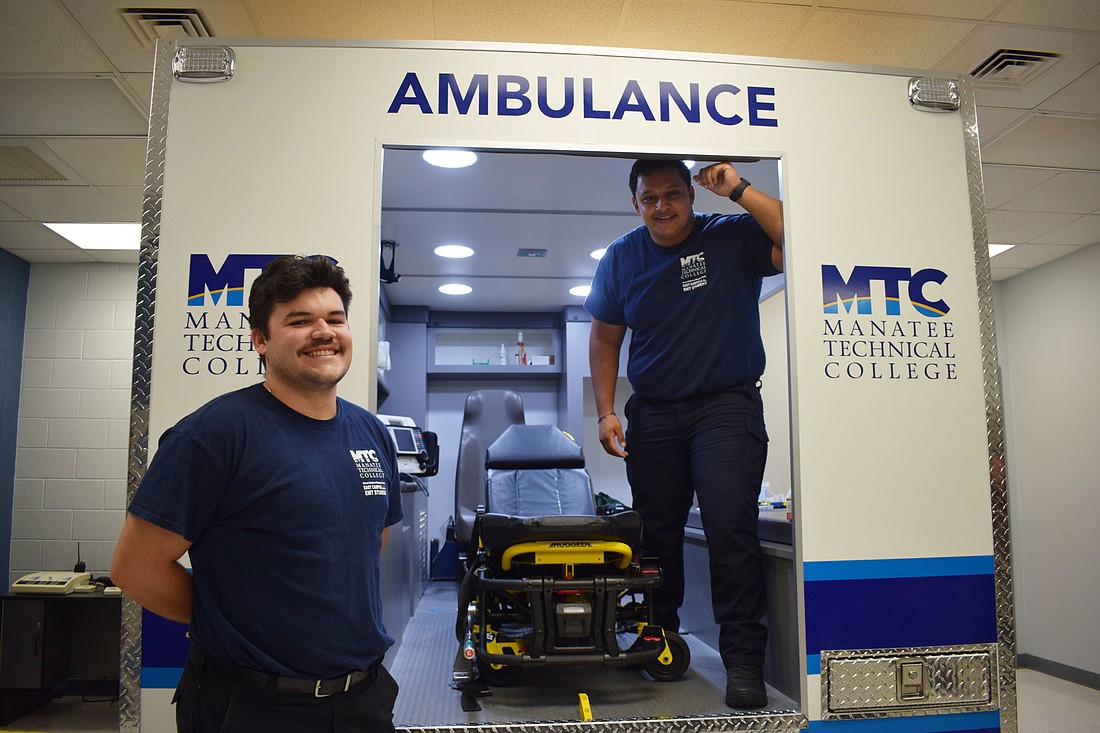- April 16, 2025
-
-
Loading

Loading

During Michael Koczersut’s first Emergency Medical Technician Program clinical, he was faced with a real emergency involving a pregnant woman.
The woman wasn’t aware of her pregnancy, and Koczersut, a student in Manatee Technical College’s EMT program, was responsible for getting the woman on the stretcher and into the ambulance so they could rush her to Blake Medical Center.
Koczersut had just learned about safe loading practices using MTC’s new ambulance simulator. He found those lessons to be important in the real world.
He said if he didn’t have access to the simulator, he would have been a detriment to the first responders who were working with him.
“About an hour later, lo and behold, I see a baby being delivered,” Koczersut said.
Students in MTC’s EMT program, which is a 300-hour program that involves going to class as well as participating in clinicals, have been using the ambulance simulator to run through different emergency scenarios, such as someone being pinned under a car, someone being dragged by a car and taking care of multiple patients at once.
“The one thing about this program is we try to push them, we over-stress them,” said Jay Bush, the director of the EMT program. “These guys have probably gone through more scenarios than most people have in 30 years of being a medic.”
The ambulance simulator has the same structure and layout of a regular ambulance, but it’s built inside a classroom without wheels. One wall of the ambulance has space for students to be able to see inside the ambulance while some students are inside the back of the ambulance practicing.
Christopher Mundell, an EMT student, said that only about three people can fit in the back of an ambulance, including the patient, so there is limited space for an instructor to guide students through each lesson and scenario.
Bush said the simulator allows students to get comfortable with being in the cramped back of an ambulance and to know where the equipment is before transitioning to practicing in the ambulance outside, where students also will have to adjust to a moving ambulance.
MTC purchased the ambulance simulator using the Strengthening Career and Technical Education for the 21st Century grant, which is a federal grant. The simulator was constructed three months ago, just in time for the new group of EMT students.
Jennifer Gilray, the assistant director of MTC’s east campus, said the EMT program is one of the most popular programs at MTC and draws a large number of students. Completion of the program is required before students can move onto other first responder courses, such as the firefighter program.
“In order to be able to get our students that experience without purchasing a full ambulance, this was something we could have using the grant funds that were available and the room we have,” Gilray said.
Bush said the simulator also is cost effective. The maintenance on the donated ambulance can be around $5,000 per year while the simulator only would need minor maintenance.
In the past, EMT students would share the donated ambulance with the paramedic program, meaning around 40 students would be using the ambulance to learn essential skills in their programs.
With the simulator, students have an easier time accessing an ambulance and more time to practice what they’re learning in class and experiencing in clinicals.
“It helps us be a little more prepared for the environment when we actually go on ride-alongs,” Mundell said. “It’s a different work environment than when we’re in an open classroom with a mannequin on the ground. You can get in (the simulator) with somebody and work, so once you go on your ride-alongs, you’re not clueless.”
Ronald Alvarez, an EMT student, said the simulator has helped orient him to the layout of an ambulance and work on different skills so he’s better prepared for his clinicals.
“Our concern is not wanting to be a burden while we’re at clinicals,” Alvarez said. “You don’t want to slow anyone down.”